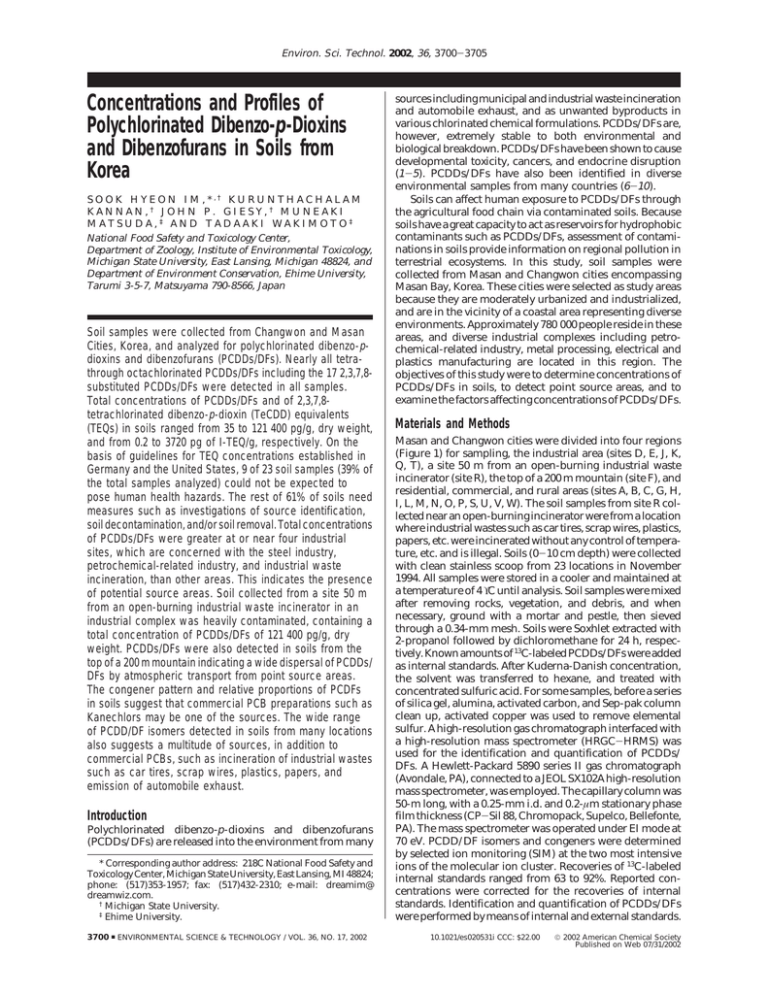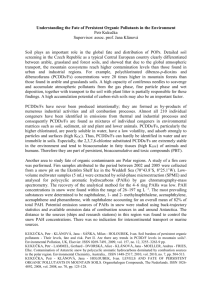Concentrations and Profiles of
advertisement

Environ. Sci. Technol. 2002, 36, 3700-3705 Concentrations and Profiles of Polychlorinated Dibenzo-p-Dioxins and Dibenzofurans in Soils from Korea S O O K H Y E O N I M , * ,† K U R U N T H A C H A L A M KANNAN,† JOHN P. GIESY,† MUNEAKI MATSUDA,‡ AND TADAAKI WAKIMOTO‡ National Food Safety and Toxicology Center, Department of Zoology, Institute of Environmental Toxicology, Michigan State University, East Lansing, Michigan 48824, and Department of Environment Conservation, Ehime University, Tarumi 3-5-7, Matsuyama 790-8566, Japan Soil samples were collected from Changwon and Masan Cities, Korea, and analyzed for polychlorinated dibenzo-pdioxins and dibenzofurans (PCDDs/DFs). Nearly all tetrathrough octachlorinated PCDDs/DFs including the 17 2,3,7,8substituted PCDDs/DFs were detected in all samples. Total concentrations of PCDDs/DFs and of 2,3,7,8tetrachlorinated dibenzo-p-dioxin (TeCDD) equivalents (TEQs) in soils ranged from 35 to 121 400 pg/g, dry weight, and from 0.2 to 3720 pg of I-TEQ/g, respectively. On the basis of guidelines for TEQ concentrations established in Germany and the United States, 9 of 23 soil samples (39% of the total samples analyzed) could not be expected to pose human health hazards. The rest of 61% of soils need measures such as investigations of source identification, soil decontamination, and/or soil removal. Total concentrations of PCDDs/DFs were greater at or near four industrial sites, which are concerned with the steel industry, petrochemical-related industry, and industrial waste incineration, than other areas. This indicates the presence of potential source areas. Soil collected from a site 50 m from an open-burning industrial waste incinerator in an industrial complex was heavily contaminated, containing a total concentration of PCDDs/DFs of 121 400 pg/g, dry weight. PCDDs/DFs were also detected in soils from the top of a 200 m mountain indicating a wide dispersal of PCDDs/ DFs by atmospheric transport from point source areas. The congener pattern and relative proportions of PCDFs in soils suggest that commercial PCB preparations such as Kanechlors may be one of the sources. The wide range of PCDD/DF isomers detected in soils from many locations also suggests a multitude of sources, in addition to commercial PCBs, such as incineration of industrial wastes such as car tires, scrap wires, plastics, papers, and emission of automobile exhaust. Introduction Polychlorinated dibenzo-p-dioxins and dibenzofurans (PCDDs/DFs) are released into the environment from many * Corresponding author address: 218C National Food Safety and Toxicology Center, Michigan State University, East Lansing, MI 48824; phone: (517)353-1957; fax: (517)432-2310; e-mail: dreamim@ dreamwiz.com. † Michigan State University. ‡ Ehime University. 3700 9 ENVIRONMENTAL SCIENCE & TECHNOLOGY / VOL. 36, NO. 17, 2002 sources including municipal and industrial waste incineration and automobile exhaust, and as unwanted byproducts in various chlorinated chemical formulations. PCDDs/DFs are, however, extremely stable to both environmental and biological breakdown. PCDDs/DFs have been shown to cause developmental toxicity, cancers, and endocrine disruption (1-5). PCDDs/DFs have also been identified in diverse environmental samples from many countries (6-10). Soils can affect human exposure to PCDDs/DFs through the agricultural food chain via contaminated soils. Because soils have a great capacity to act as reservoirs for hydrophobic contaminants such as PCDDs/DFs, assessment of contaminations in soils provide information on regional pollution in terrestrial ecosystems. In this study, soil samples were collected from Masan and Changwon cities encompassing Masan Bay, Korea. These cities were selected as study areas because they are moderately urbanized and industrialized, and are in the vicinity of a coastal area representing diverse environments. Approximately 780 000 people reside in these areas, and diverse industrial complexes including petrochemical-related industry, metal processing, electrical and plastics manufacturing are located in this region. The objectives of this study were to determine concentrations of PCDDs/DFs in soils, to detect point source areas, and to examine the factors affecting concentrations of PCDDs/DFs. Materials and Methods Masan and Changwon cities were divided into four regions (Figure 1) for sampling, the industrial area (sites D, E, J, K, Q, T), a site 50 m from an open-burning industrial waste incinerator (site R), the top of a 200 m mountain (site F), and residential, commercial, and rural areas (sites A, B, C, G, H, I, L, M, N, O, P, S, U, V, W). The soil samples from site R collected near an open-burning incinerator were from a location where industrial wastes such as car tires, scrap wires, plastics, papers, etc. were incinerated without any control of temperature, etc. and is illegal. Soils (0-10 cm depth) were collected with clean stainless scoop from 23 locations in November 1994. All samples were stored in a cooler and maintained at a temperature of 4 °C until analysis. Soil samples were mixed after removing rocks, vegetation, and debris, and when necessary, ground with a mortar and pestle, then sieved through a 0.34-mm mesh. Soils were Soxhlet extracted with 2-propanol followed by dichloromethane for 24 h, respectively. Known amounts of 13C-labeled PCDDs/DFs were added as internal standards. After Kuderna-Danish concentration, the solvent was transferred to hexane, and treated with concentrated sulfuric acid. For some samples, before a series of silica gel, alumina, activated carbon, and Sep-pak column clean up, activated copper was used to remove elemental sulfur. A high-resolution gas chromatograph interfaced with a high-resolution mass spectrometer (HRGC-HRMS) was used for the identification and quantification of PCDDs/ DFs. A Hewlett-Packard 5890 series II gas chromatograph (Avondale, PA), connected to a JEOL SX102A high-resolution mass spectrometer, was employed. The capillary column was 50-m long, with a 0.25-mm i.d. and 0.2-µm stationary phase film thickness (CP-Sil 88, Chromopack, Supelco, Bellefonte, PA). The mass spectrometer was operated under EI mode at 70 eV. PCDD/DF isomers and congeners were determined by selected ion monitoring (SIM) at the two most intensive ions of the molecular ion cluster. Recoveries of 13C-labeled internal standards ranged from 63 to 92%. Reported concentrations were corrected for the recoveries of internal standards. Identification and quantification of PCDDs/DFs were performed by means of internal and external standards. 10.1021/es020531i CCC: $22.00 2002 American Chemical Society Published on Web 07/31/2002 FIGURE 1. Spatial distributions of total concentrations of PCDDs/ DFs, and locations (sites A to W) from which soil samples were collected from Masan and Changwon cities, Korea. A fly ash sample containing known compositions of PCDD/ DF congeners was used as a reference to identify individual PCDDs/DFs. Procedural blanks were analyzed for every five samples to check for interferences and laboratory contamination. Interferences were not found in blanks. Concentrations of PCDDs/DFs are reported as the sum of all the quantifiable isomers and congeners. Concentrations that were less than the method detection limits (MDL) were assigned a value zero when calculating means. Results and Discussion Nearly all tetra- through octachlorinated PCDDs/DFs including the 17 2,3,7,8-substituted PCDDs/DFs were detected in all samples. Chromatograms of all the tetra- through octaPCDD/DF isomers detected in one of the soil samples analyzed at site R are shown (Figure 2). Total concentrations of PCDDs/DFs in soil samples ranged from 35 to 121 400 pg/g, dry weight (dry wt) (Table 1). Total concentrations of PCDDs/DFs were comparable to those of other relevant studies in other countries. Concentrations of PCDDs/DFs in soils from the United Kingdom ranged from 47 to 9680 pg/g, dry wt (11), and soils near a former copper smelter in Germany ranged from 1770 to 266 700 pg/g, dry wt (12). Two of the soils from an urban area and an area near Lake Kasumigaura in Japan contained PCDDs/DFs concentrations from 1610 to 2170 pg/g, dry wt (13). This suggests that the concentrations of PCDDs/DFs in soils from Korea are similar to those in other industrialized countries. In our previous study (14), sediments from Masan Bay, Korea, also contained total concentrations of PCDDs/DFs comparable to those reported in other industrialized countries. Among PCDD/DF isomers, 2,3,7,8-substituted PCDDs/ DFs are more toxic and persistent than the other isomers of PCDDs/DFs. Concentrations of 2,3,7,8-tetrachlorinated dibenzo-p-dioxin (2,3,7,8-TeCDD) equivalents (TEQs) in soils estimated based on I-TEFs (15) ranged from 0.2 to 3720 pg/ g, dry wt. In particular, soils sampled from a site 50 m (site R) from an open-burning industrial waste incinerator in an industrial complex contained all 17 2,3,7,8-substituted PCDDs/DFs including two isomers that coeluted. The concentration of TEQ in this sample was 3720 pg/g, dry wt, which was 3.7-fold greater than that of the “level of concern” of 1000 pg of I-TEQ/g, dry wt proposed by Kimbrough et al. (16). Six of 17 2,3,7,8-substituted PCDDs/DFs were also detected in soils from the top of a mountain (site F), which contained 0.2 pg of TEQ/g, dry wt. Detectable concentration of 2,3,7,8-TeCDD, which is the most toxic isomer of the 17 2,3,7,8-substituted PCDDs/DFs, was found at seven sampling sites which are mostly industrial locations. Few guidelines for PCDDs/DFs in soils have been suggested. Germany (17) has guidelines based on TEQ concentrations to protect the human health implications and the environment. It has been recommended that no restrictions be placed on use of soils with TEQ concentrations less than 5 pg/g, dry wt. Soils containing concentrations of TEQs between 5 and 40 pg/g, dry wt, should be used with precaution, and sources of PCDDs/DFs contamination should be identified. Soils with concentrations greater than 40 pg of TEQ/g, dry wt, should not be used to cultivate fruits, legumes, or forage plants. Soils containing more than 100 pg of TEQ/g, dry wt, in playgrounds should be removed (0-10 cm depth). For soils containing concentrations greater than 1000 pg of TEQ/g, dry wt, measures should be taken to reduce contact with soils as with residential areas. The Agency for Toxic Substances and Disease Registry in the United States (18) has adopted interim policy guidelines for PCDDs/DFs in residential soils near or on hazardous waste sites. When concentrations of TEQs exceed 50 pg of TEQ/g, dry wt, evaluation of site-specific factors such as pathway analysis and soil cover are needed. Actions to be taken when soil concentrations exceed 1000 pg/g, dry wt, include surveillance and research of exposure investigations. In this study, TEQ concentrations in 9 of 23 soil samples were less than 5 pg/g, dry wt, and 11 soil samples contained TEQs between 5 and 40 pg/g, dry wt. Concentrations of TEQs greater than 40, 100, and 1000 pg/g, dry wt, were detected in one soil sample, respectively. We suggest based on the above guidelines, that 9 of 23 soil samples (39%) represent no human health hazards, and the remaining 61% of soils need measures such as investigations of source identification, soil decontamination, and/or soil removal. Total concentrations of PCDDs/DFs in soil from each sampling site and their spatial distributions were used to determine potential source areas. Concentrations of PCDDs/ DFs were generally greater at or near industrial areas (814 to 121 400 pg/g, dry wt) such as at sites D, E, J, K, Q, T, and R than other sites in residential, commercial, or rural areas (35 to 1476 pg/g, dry wt) (Figure 1). In particular, concentrations of PCDDs/DFs at sites D, E, and Q were greater, ranging from 3639 to 9704 pg/g, dry wt. Soil from a site 50 m (site R) from an open-burning incinerator of industrial waste in an industrial complex contained PCDDs/DFs at 121 400 pg/ g, dry wt. This observation suggests that industrial activities such as chemical manufacturing, steel industry, electrical processes, and industrial waste incineration affect soil contaminations, and industrial sites including D, E, Q, and R could be potential point source areas of PCDDs/DFs in Masan and Changwon areas. Previously, we have reported (14) PCDDs/DFs in sediments from Masan Bay, which is surrounded by Masan and Changwon cities. Sediment samples collected near the current soil sampling sites D, E, Q, and R also contained greater concentrations of PCDDs/ DFs than the other sites, which indicates that industrial activities contribute to PCDDs/DFs contamination in both oceanic and terrestrial ecosystems. Although relatively great concentrations of PCDDs/DFs were observed in industrial areas, detection of PCDDs/DFs also occurred in soil samples VOL. 36, NO. 17, 2002 / ENVIRONMENTAL SCIENCE & TECHNOLOGY 9 3701 FIGURE 2. Mass chromatograms of PCDD/DF isomers detected in soil samples at site R. from residential, commercial, and rural areas including a sample from the top of a 200 m mountain which is not influenced by localized human activities. This suggests wide dispersal of PCDDs/DFs from source areas by atmospheric transport and deposition to remote sites. Different sources of PCDDs/DFs are characterized by different congener and homologue patterns (19, 20). The homologue and isomer patterns of PCDDs/DFs were used to discern characteristics of samples and to identify possible sources of PCDDs/DFs. Homologue profiles of PCDDs/DFs in soils at sites R, D, Q, and F, and in PCB preparations (21) are shown (Figure 3). Sites R, D, and Q are suggested as potential source areas. Soils collected at site R were 50 m from an open-burning industrial waste incinerator, and soils of sites D and Q were near a steel industry and from a petrochemical-related industry, respectively. Soils from site F were from the top of a 200 m mountain. Each homologue group from tetra- through octachlorinated PCDDs and PCDFs in soil samples (sites R, D, Q, F) was normalized to the total sum of PCDDs and of PCDFs, respectively, and in PCB preparations was normalized to the total sum of PCDDs/DFs. Soils from site R contained the greatest total concentration of PCDDs/DFs and TEQs. Several open-burning incinerators in the industrial complex are used for the incineration of industrial waste such as car tires, scrap wires, plastics, papers, etc., from diverse factories. Soils from site R were collected near one of those incinerators, and it is suggested that the homologue profiles of PCDDs/DFs at site R are the result of multiple industrial waste incinerations rather than specific industrial production. Almost all of the PCDD/DF isomers 3702 9 ENVIRONMENTAL SCIENCE & TECHNOLOGY / VOL. 36, NO. 17, 2002 were detected including all 17 2,3,7,8-substituted PCDDs/ DFs (Figure 2). Total concentrations of PCDFs (87 249 pg/g, dry wt) were 2.6 times greater than those of PCDDs (34 158 pg/g, dw). Among PCDF homologues, hexachlorinated dibenzofurans (HeCDF) predominated, and 83% of total concentrations of PCDFs were attributable to lesser chlorinated dibenzofurans such as tetra-, penta-, and hexachlorinated dibenzofurans homologues (TeCDF, PeCDF, and HeCDF). Octachlorinated dibenzo-p-dioxins (OCDD) accounted for the greatest proportion of PCDDs, with the second greatest contribution from hexachlorinated dibenzop-dioxins (HeCDD). A study has been reported (22) of soils affected by scrap cars incineration and recycling of small scrap wire, and those isomer characteristics of PCDDs/DFs correspond to soils collected from site R of this study. Soils from site D, collected near a steel industry, contained total concentrations of PCDDs and PCDFs that were similar and had a PCDFs to PCDDs ratio of 1. However, concentrations of each PCDDs/DFs homologue varied considerably. Approximately 80 and 92% of the total concentrations of PCDDs/DFs were attributable to the less chlorinated congeners such as TeCDD/DF, PeCDD/DF, and HeCDD/DF. It has been suggested that commercial polychlorinated biphenyls (PCBs) are one of the sources of PCDFs in the environment (21, 23, 24). Homologue profiles of PCDFs in environmental matrixes have suggested an elevated proportion of TeCDF followed in decreasing order by PeCDF, HeCDF, HpCDF, and OCDF (21), suggesting a pattern observed in commercial PCBs (Figure 3). Nearly all PCDF isomers and homologues also occur in Japanese PCB TABLE 1. 2,3,7,8-Substituted and Total PCDDs/DFs Concentrations (pg/g, dry wt) in Soils from Masan and Changwon Cities, Koreaa sampling locations A B C D E F G H I J K L M N O P S T U V W 2378-TeCDD others total TeCDD PCDDs/DFs <0.1 128 128 <0.1 30.4 30.4 <0.1 21.2 21.2 3 624 627 6 175 181 <0.1 4.7 4.7 <0.1 3 3 <0.1 117 117 <0.1 20 20 1 14.8 15.8 3 21.6 24.6 <0.1 1 1 <0.1 2 2 <0.1 23 23 <0.1 11 11 3 237 240 1 50 51 Q 48 595 643 R <0.1 8 8 <0.1 68 68 <0.1 3 3 <0.1 26 26 <0.1 3 3 12378-PeCDD others total PeCDD 1.5 70.4 71.9 1 22 23 <0.1 3.2 3.2 13 658 671 8 185 193 <0.1 1.6 1.6 1.5 6 7.5 1 189 190 <0.1 31.6 31.6 0.8 16.4 17.2 <0.1 46.6 46.6 <0.1 41 41 <0.1 2 2 <0.1 25 25 <0.1 30 30 2 73 75 3 81 84 272 3004 3276 <0.1 4 4 2 47 49 <0.1 <0.1 <0.1 <0.1 11 11 <0.1 <0.1 <0.1 123478-HeCDD 123678123789others total HeCDD 2 4 2 76 84 0.4 0.7 4.7 13.8 19.6 0.5 0.3 <0.1 6 6.8 12 34 19 489 554 24 70 79 586 759 <0.1 <0.1 <0.1 1.7 1.7 <0.1 <0.1 <0.1 4 4 <0.1 4 4 259 267 <0.1 10 3 175 188 <0.1 5 6 59 70 <0.1 7 5 156 168 <0.1 4 2 116 122 <0.1 <0.1 <0.1 8 8 <0.1 <0.1 1 20 21 1 17 5 203 226 5 8 10 53 76 3 5 3 69 80 228 486 410 6890 8014 <0.1 <0.1 1 5 6 <0.1 <0.1 2 53 55 <0.1 <0.1 <0.1 11 11 <0.1 <0.1 5 8 13 <0.1 <0.1 <0.1 <0.1 <0.1 1234678-HpCDD others total HpCDD 11 16 27 <0.1 3 3 1 1.3 2.3 108 130 238 1188 1102 2290 1 1.3 2.3 10.2 16 26.2 43 62 105 68 70 138 97 100 197 69 80 149 58 60 118 2.6 3.1 5.7 11 12 23 74 87 161 22 32 54 56 55 111 2735 3394 6129 9 9 18 10 16 26 10 13 23 3 7 10 2 2.7 4.7 VOL. 36, NO. 17, 2002 / ENVIRONMENTAL SCIENCE & TECHNOLOGY OCDD 69 23 17 213 2242 48 38 76 147 276 326 450 19 92 180 138 2198 16096 120 22 53 56 17 2378-TeCDF others total TeCDF 8 156 164 2 50.1 52.1 <0.1 0.9 0.9 36 1064 1100 96 801 897 <0.1 <0.1 <0.1 <0.1 <0.1 <0.1 3 63 66 0.4 244 244 5 82.6 87.6 8 220 228 <0.1 105 105 0.1 0.6 0.7 2 41.2 43.2 4 323 327 14 253 267 22 187 209 515 5183 5698 2 4.9 6.9 4 126 130 1 44 45 0.6 28.1 28.7 0.2 3.2 3.4 12348+12378-PeCDF 23478others total PeCDF 13 6 97 116 3 2 26.7 31.7 0.1 <0.1 6.5 6.6 24 39 525 588 83 68 221 372 0.3 <0.1 2.4 2.7 3 <0.1 43 46 6 7 102 115 3 8 95 106 7 5 17.2 29.2 6 2 115 123 <0.1 5 164 169 0.3 0.3 0.9 1.5 3 3 36.2 42.2 7 17 108 132 24 19 223 266 22 21 186 229 1794 2239 10957 14990 0.4 0.4 2.5 3.3 13 14 160 187 <0.1 <0.1 9 9 2 1 14.4 17.4 0.2 <0.1 0.8 1 123478+123479-HeCDF 123678123789234678others total HeCDF 24 14 4 13 96 151 3 3 <0.1 1.9 14.3 22.2 46 0.5 9 9 11.7 76.2 46 48 9 31 278 412 211 181 46 180 578 1196 0.9 0.6 <0.1 <0.1 3.9 5.4 1 1 3 <0.1 43.6 48.6 11 11 2 15 80 119 5 5 10 17 89 126 6 2 <0.1 4 11.4 23.4 7 9 9 <0.1 97 122 8 9 6 <0.1 106 129 0.4 <0.1 <0.1 <0.1 2.9 3.3 4 <0.1 <0.1 <0.1 22 26 6 6 10 14 92 128 46 15 8 31 181 281 46 41 6 37 339 469 6770 5932 761 6810 31242 51515 1 <0.1 0.4 0.4 4 5.8 28 27 7 21 146 229 5 5 3 8 76 97 1 1 0.6 <0.1 6 8.6 0.5 0.7 <0.1 <0.1 2.5 3.7 1234678-HpCDF 1234789others total HpCDF 48 <0.1 7 55 6 <0.1 2 8 2 <0.1 1 3 93 4 30 127 658 39 273 970 2 <0.1 1 3 13 <0.1 3 16 30 <0.1 4 34 15 <0.1 3 18 55 2 14.2 71.2 42 3 24 69 68 <0.1 19 87 1.4 <0.1 1 2.4 7 <0.1 2 9 11 <0.1 2 13 58 <0.1 21 79 55 2 20 77 8455 372 1882 10709 4 <0.1 3 7 89 4 13 106 15 <0.1 3 18 <0.1 <0.1 2 2 2 <0.1 <0.1 2 OCDF <0.1 <0.1 <0.1 50 604 <0.1 <0.1 <0.1 <0.1 27 <0.1 <0.1 <0.1 <0.1 <0.1 <0.1 131 4330 <0.1 <0.1 <0.1 <0.1 <0.1 total PCDDs total PCDFs total PCDDs+PCDFs ratio PCDFs/PCDDs TEQs (pg/g, dry wt) 380 486 866 1.3 12.2 99 114 213 1.2 3.3 51 87 138 1.7 6.6 2303 2277 4580 1 56 5665 4039 9704 0.7 159 58 11 69 0.2 0.2 79 111 190 1.4 1.7 755 334 1089 0.4 10.1 525 495 1020 0.9 10.2 576 238 814 0.4 8.9 714 542 1256 0.8 10.3 732 490 1222 0.7 7.1 37 8 45 0.2 0.3 184 120 304 0.7 2.6 608 600 1208 1 16.2 583 893 1476 1.5 29.3 2524 1115 3639 0.4 33.9 34158 87249 121400 2.6 3720 156 23 179 0.1 1 220 652 872 3 18.6 90 169 259 1.9 2.5 116 57 173 0.5 1.5 25 10 35 0.4 0.2 9 3703 a TeCDD/DF ) tetrachlorinated dibenzo-p-dioxin/furan. PeCDD/DF ) pentachlorinated dibenzo-p-dioxin/furan. HeCDD/DF ) hexachlorinated dibenzo-p-dioxin/furan. HpCDD/DF ) heptachlorinated dibenzo-pdioxin/furan. OCDD/DF ) octachlorinated dibenzo-p-dioxin/furan. TEQs ) toxic equivalency quotients. FIGURE 3. Homologue profiles of PCDDs/DFs in soil sampling sites R, D, Q, and F, and in PCB preparations (21). Soils from site R were from a site 50 m from an open-burning incinerator of various industrial waste in an industrial complex. Soils from sites D and Q were from near a steel industry and from a petrochemical related industry, respectively. Soils from site F were from the top of a 200 m mountain. preparations such as Kanechlors 300, 400, 500, and 600 (24). The TeCDF homologue represented 58% of the total PCDFs found in Kanechlor 300 followed in decreasing order by PeCDF, HeCDF, HpCDF, and OCDF. TeCDF, PeCDF, and HeCDF homologues contributed 94% of the total PCDFs in Kanechlor 300. Nearly all PCDF isomers were detected in soils at site D, and TeCDF contributed the greatest proportions, accounting for 48% of the total PCDF concentrations. The relative proportion of TeCDF was followed in decreasing order by PeCDF, HeCDF, HpCDF, and OCDF. Approximately 92% of the total PCDF concentrations were attributable to TeCDF, PeCDF, and HeCDF. Relative proportions of PCDF homologues in soils from site D correlated well with those in Kanechlor 300. Furthermore, significant linear correlations (r ) 0.98) existed between PCDFs homologue compositions in soils at site D and Kanechlor 300 (Figure 4). Similar to that 3704 9 ENVIRONMENTAL SCIENCE & TECHNOLOGY / VOL. 36, NO. 17, 2002 for Kanechlor 300, a significant correlation existed (r ) 0.95) between the homologue distribution of PCDFs in soils from site D and Kanechlor 400, and Kanechlor 500 (r ) 0.54). These similar homologue patterns, and proportions of TeCDF through OCDF between soils from site D and PCB preparations, suggest that commercial PCBs such as Kanechlors 300, 400, and/or 500 may be one of the sources of PCDFs found in soils. Thermal processes such as municipal and chemical waste incineration and other combustion processes can result in the production of a range of PCDD/DF isomers (25, 26). A wide range of tetra- through octachlorinated PCDD/DF isomers were identified in soil samples from site D, which indicates that incineration and combustion-related processes have also contributed to PCDDs/DFs in soils. Soils at site Q were collected from an area near a petrochemical-related industry in the industrial complex. detected in soils from the top of a 200 m mountain, reflecting wide dispersal of PCDDs/DFs, and atmospheric transport and deposition from point source areas. The homologue pattern and compositions of PCDFs in soils suggested that commercial PCB preparations such as Kanechlors 300, 400, and/or 500 may be one of the sources. The wide range of PCDD/DF isomers detected in many locations also suggests the presence of a multitude of sources, in addition to commercial PCBs, such as incineration of industrial wastes such as car tires, scrap wires, plastics, and papers, and emission of automobile exhaust. Literature Cited FIGURE 4. Correlation of relative proportion of PCDFs homologues at site D of this study (x-axis) with Kanechlor (KC) 300 preparation given by Wakimoto et al. (24) (y-axis). Each homologue is expressed as the percentage of total PCDFs. Total concentrations of PCDDs/DFs were 3639 pg/g, dry wt, and all 17 2,3,7,8-substituted PCDDs/DFs were found with a total concentration of TEQ of 33.9 pg/g, dry wt. Concentrations of PCDDs were about 2-fold greater than those of PCDFs. OCDD accounted for the greatest proportion, accounting for 87% of the total PCDD concentrations, and more than 81% of the total concentration of PCDFs were attributable to lesser chlorinated TeCDF, PeCDF, and HeCDF homologues. Soils from site F were collected from the top of a 200 m mountain, which has not been directly influenced by localized human activities. This location received inputs of PCDDs/ DFs only via atmospheric deposition. At this location, total concentration of PCDDs (58 pg/g, dry wt) was greater than that of PCDFs (11 pg/g, dry wt). PeCDF, HeCDF, and HpCDF homologues and all tetra- through octachlorinated dibenzop-dioxin homologues were detected. However, none of TeCDFs and OCDF was detected. In particular, OCDD contributed 82% of total PCDD concentrations. A similar study (27) presented concentrations of PCDDs/DFs with the homologue patterns closely matching that observed in soils in remote sites. PCDDs/DFs derived from atmospheric transport of combustion-derived particulates have a homologue profile that is dominated by OCDD with greater concentrations of PCDDs than of PCDFs. The pattern of PCDDs/DFs observed at site F are consistent with those of atmospheric transport and deposition of PCDDs/DFs. Incineration, automobile exhaust, chemical manufacturing processes, and other point sources in terrestrial environment were the possible sources of PCDDs/DFs in soils at site F. In summary, nearly all tetra- through octachlorinated PCDDs/DFs were detected in all soil samples collected from Changwon and Masan cities of Korea. Total concentrations of PCDDs/DFs in soil samples were comparable to those in other industrialized countries. On the basis of guidelines for PCDDs/DFs in Germany and the United States, concentrations in 9 of 23 soil samples (39% of the total samples analyzed) could not be expected to pose human health hazards. The rest of 61% of soils need measures such as investigations of source identification, soil decontamination, and/or soil removal. Total concentrations of PCDDs/DFs were greater at or near four industrial sites, which indicates the presence of potential point source areas. In particular, soil at a site 50 m from an open-burning industrial waste incinerator in an industrial complex was heavily contaminated, and contained all 17 2,3,7,8-substituted PCDDs/DFs including two isomers that coeluted. PCDDs/DFs were also (1) Kociba, R. J.; Keyes, D. G.; Beyer, J. E.; Carreon, R. M.; Wade, C. E.; Dittenber, D. A.; Kalnine, R. P.; Frauson, L. E.; Park, C. N.; Barnard, S. D.; Hummel, R. A.; Humiston, C. G. Toxicol. Appl. Pharmacol. 1978, 46, 279-303. (2) Murray, F. J.; Smith, F. A.; Nitschke, K. D.; Humiston, C. G.; Kociba, R. J.; Schwetz, B. A. Toxicol. Appl. Pharmacol. 1979, 50, 241-252. (3) Peterson, R.; Theobald, H.; Kimmel, G. Crit. Rev. Toxicol. 1993, 23, 283-335. (4) Aylward, L. L.; Hays, N. S.; Karch, M. J.; Paustenbach, D. J. Environ. Sci. Technol. 1996, 30, 3534-3543. (5) Schantz, S. L.; Bowman, R. E. Neurotoxicol. Teratol. 1989, 11, 9-13. (6) Giesy, J. P.; Jude, D. J.; Tillitt, D. E.; Gale, R. W.; Meadows, J. C.; Zajieck, J. L.; Peterman, P. H.; Verbrugge, D. A.; Sanderson, J. H.; Schwartz, T. R.; Tuchman, M. L. Environ. Toxicol. Chem. 1997, 16, 713-724. (7) Kannan, K.; Ueda, M.; Shelby, A.; Mendonca, M. T.; Kawano, M.; Matsuda, M.; Wakimoto, T.; Giesy, J. P. Arch. Environ. Contam. Toxicol 2000, 38, 362-370. (8) Gardner, A. M.; White, K. D. Chemosphere 1990, 21, 215-222. (9) Eitzer, B. D. Environ. Sci. Technol. 1993, 27, 1632-1637. (10) Im, S. H.; Min, B. Y.; Matsuda, M.; Wakimoto, T. J. Environ. Chem. 1995, 5, 625-636. (11) Rappe, C.; Kjeller, L. O. Chemosphere 1987, 16, 1775-1780. (12) Hagenmaier, H.; She, J.; Lindig, C. Chemosphere 1992, 25, 14491456. (13) Sakurai, T.; Kim, J. G.; Suzuki, N.; Nakanishi, J. Chemosphere 1996, 33, 2007-2020. (14) Im, S. H.; Kannan, K.; Matsuda, M.; Giesy, J. P.; Wakimoto, T. Environ. Toxicol. Chem. 2002, 21, 245-252. (15) Kutz, F. W.; Barnes, D. G.; Bottimore, D. P.; Greim, H.; Bretthauer, E. W. Chemosphere 1990, 20, 751-757. (16) Kimbrough, R. D.; Falk, H.; Stehr, P. J. Toxicol. Environ. Health 1984, 14, 47-93. (17) Schulz, D. Chemosphere 1993, 27, 501-507. (18) De Rosa, C. T.; Brown, D.; Dhara, R.; Garrett, W.; Hansen, H.; Holler, J.; Jones, D.; Jordan-Izaguirre, D.; O’Connor, R.; Pohl, H.; Xintaras, C. Dioxin and Dioxin-Like Compounds in Soil, Part 1: ATSDR Interim Policy Guideline. Agency for Toxic Substances and Disease Registry, U.S. Department of Health and Human Services: Atlanta, Georgia, 1997; Vol 13, pp 759768. (19) Alcock, R. E.; Jones, K. C. Environ. Sci. Technol. 1996, 30, 31333143. (20) Wenning, R. J.; Harris, M. A.; Finley, B.; Paustenbach, D. J.; Bedbury, H. Ecotoxicol. Environ. Saf. 1993, 25, 103-125. (21) Hagenmaier, H.; Lindig, C.; She, J. Chemosphere 1994, 29, 21632174. (22) Wijnen, J. H. V.; Liem, A. K. D.; Olie, K.; Zorge, J. A. V. Chemosphere 1992, 24, 127-134. (23) Erickson, M. D.; Swanson, S. E.; Flora, J. D. Jr.; Hinshaw, G. D. Environ. Sci. Technol. 1989, 23, 462-470. (24) Wakimoto, T.; Kannan, N.; Ono, M.; Tatsukawa, R.; Masuda, Y. Chemosphere 1988, 17, 743-750. (25) Yasuhara, A.; Ito, H.; Morita, M. Environ. Sci. Technol. 1987, 21, 971-979. (26) Sakai, S.; Yamane, H.; Takatsuki, H.; Aoki, I. Organohalogen Compd. 2000, 45, 340-343. (27) Czuczwa, J. M.; Hites, R. A. Environ. Sci. Technol. 1986, 20, 195200. Received for review January 16, 2002. Revised manuscript received May 20, 2002. Accepted June 18, 2002. ES020531I VOL. 36, NO. 17, 2002 / ENVIRONMENTAL SCIENCE & TECHNOLOGY 9 3705







